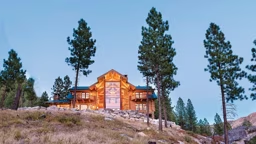
Photo: Ales Krivec / Unsplash
If you're planning to build a new home, selecting your site is as vital to the completed project as the design of the structure. For most of us, the appeal of a timber home comes not only from the building itself, but also from the surrounding environment and how the home is situated on the plot.
A satisfying design always considers the aesthetics of the land and integrates with the environment in an organic way. If you're considering building in a development or on a parcel already subdivided for new homes, you'll have fewer worries than if you're buying raw, undeveloped land. You'll know that the plot has road and utility access and is attached to a public sewer system (or is suitable for a sewer septic system). But the problem with a development is that you rarely have a green light in terms of what and how to build. You can expect to have to comply with restrictive covenants that will dictate many of your aesthetic choices, and there likely will be an architectural review committee in place that will limit your vision.
Moreover, you'll simply have less control in choosing your natural environment. Choosing to build on raw land allows you to find a site that appeals to you in terms of its views and scenery, and gives you infinitely more leeway to make aesthetic choices in your design. The tradeoff is that with every freedom afforded by raw land, you're faced with potential challenges. Building on raw land is not simply a matter of picking a spot with a lovely view and plunking your home down on it. The good news, though, is that you can build on just about any spot, no matter how physically or logistically challenging — assuming your budget can meet these challenges.
The First Step
Savvy individuals searching for land for sale use a variety of methods to find available property, including scanning local newspapers, querying farmers in rural communities, and researching bank foreclosures, tax sales or evictions. For most people, a real estate agent is the best source for identifying sites, especially when your search covers an area far away from your current residence.
No matter how you look for an appropriate site, once you've identified some candidates, your primary allies are due diligence and common sense. You wouldn't buy a car without actually seeing it or taking it for a test drive, and the same is true with raw land. Plan to visit and walk over any property under consideration. You should also plan to investigate adjoining properties. In rural or unzoned areas, you'll want to know whether there are large-scale farming operations that will affect potential value and your own quality of life; imagine buying a plot of land without realizing you're downwind from a commercial farm or landfill! In my own experience, an uncle owned one of the most beautiful and historic homes in the county — within hearing distance of a drag strip.
Agents and Attorneys
A real estate agent should, of course, make clients aware of the surrounding conditions, but if there are two ways to access a property — one through a verdant, tree-lined glen and the other by a drag strip or a commercial farm — which do you suppose the agent will choose? Lou Morrison, a broker with Scenic Realty and Auction in Roaring Gap, N.C., cautions that "you can only control what you own, not what adjoins you." Often, his clients are planning to build a vacation or retirement home far from their primary residence; he advises them to take an afternoon and drive around to get a feel for the surrounding environment.
Aside from showing you what's on the market, it's the real estate agent's responsibility to inform you of material facts, such as easements or highway improvements. An easement grants the right of someone other than the property owner to use a tract of land; examples include giving a neighbor road access or the right to ride a horse or limiting, for conservation purposes, how the land can be developed. Another key ally in buying raw land is a real estate attorney. Legally speaking, you can do title searches yourself, but land records, overseen by the Registrar of Deeds in the county seat, can be extremely confusing. A real estate attorney is equipped to search and interpret titles, and many local attorneys actually have the transactions in their community memorized.
Moreover, attorneys will also have connections with title insurance companies, which insure you in the event of a defect or hindrance with your purchase. An attorney is also vital, of course, in drawing up a contract. While there are standard forms dealing with the purchase of residential properties, an attorney will need to draft any contingencies that might be attached to the form. Examples of contingencies include the stipulation that a normal drain field for a sewer septic system is buildable on the land, or that road access to your property is feasible. If these contingencies are not met, you have a way out of your offer to buy.
Other Experts
Mark Johnson, an architect based in Kalispell, Montana, feels that when you find a tract of raw land appealing enough to consider purchasing, you should consult at least one expert to help you assess the land. This can be a geotechnical engineer, a surveyor, an architect, or a designer. However, Johnson feels that your single best resource is a locally based landscape architect, "because they deal with the land itself. They can suggest good building spots and point out topographical irregularities."
Sewer and Water Issues
Before you can build a home, a health inspector will visit your site to conduct a perc test that will establish the land's rate of drainage for purposes of a septic system. This will dictate where you can place your primary and repair drainage fields, or determine if you have to install a custom system, which can raise sewer septic costs by up to five times. But there's a Catch-22: You can't have the health official visit the site until the ground is roughly staked out, and you can't stake out the land until you own it and have your general design in place.
As noted earlier, your offer to buy can be contingent on being able to install a normal system, but before getting into such negotiations, it's wise to evaluate your property for sewer septic concerns and to be sure that there is an adequate source of water to operate the system. Without hiring someone to evaluate your property, you can do some things on your own to get a sense of the type of system the property can accommodate. It is by no means an immutable law, but it is a general rule that what your neighbor has, you'll have. Ask neighbors about their sewer and water issues.
Check to see what their living conditions are like in terms of the water table and flooding, and find out how deep they had to dig for their well. Beware of lowlands or rocky soil, and keep in mind that clay drains poorly while sandy soil drains too rapidly. Ponds and streams can be contaminated by sewer septic systems, so standing or live water will dictate placement of your primary and repair fields. The county health department will be able to tell you how many feet away your septic field must be from water.
Electricity
Electrical connection is generally more expensive than septic and water considerations. Lou Morrison cautions that "people in the city often can't imagine that there are areas without electricity. But don't assume anything about utility access. You don't have to be that far away from the grid to have access problems." You might be able to connect to lines on an adjoining property, but your neighbor has the sole right to grant or deny an easement.
Fortunately, utility companies will send an engineer to a property to calculate the installation expense based on distance and number of poles. It's also worth asking the local power company what expansion is planned and if they are willing to help subsidize installation in order to inspire future development.
Road Access
Aside from having the title analyzed to be sure your property is not land-locked, you'll need to do some research in terms of road access. Will a special road need to be built to bring in the equipment to dig a well? Will a forklift need to be brought in to lift the heavy? If so, you'll need to factor in the cost of building one-time access, which might run into five figures.
You'll also want to investigate potential expansion of public roads on or around your desired site. The state department of transportation's engineering department can answer your questions about future development, since proposals are docketed years in advance.
Environmental Issues
Environmental regulation is another potential hindrance to where or how you can build. While beyond the scope of this article, be sure to ask your agent, attorney, neighbors, and regulatory agencies about these concerns.
Conclusion
With so many gray areas to contend with in the purchase of raw land, it might seem an overwhelming task, and you may opt to take the safe approach and buy a developed tract. But if you wish to create a timber home that blends harmoniously with a natural environment that deeply touches you, the rewards of wisely choosing a plot of raw land will be worth the effort.











